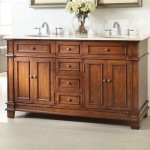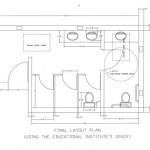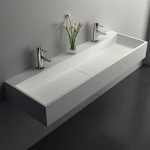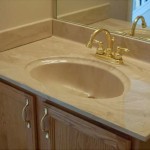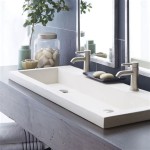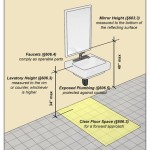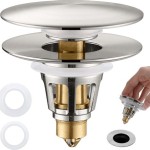Maximize Your Bathroom Space with Space-Saving Vanities
Bathrooms, often the smallest rooms in a house or apartment, present unique design challenges. Optimizing space while maintaining functionality and aesthetics is a primary concern, particularly when selecting fixtures. Space-saving bathroom vanities emerge as a solution, addressing the need for storage and a washing area without overwhelming the available square footage. These vanities are specifically designed to maximize utility within limited dimensions, making them ideal for small apartments, guest bathrooms, and powder rooms where every inch counts.
The concept of space-saving in bathroom design goes beyond simply reducing the overall size of the vanity. It involves careful consideration of storage solutions, dimensions, and installation methods. A well-designed space-saving vanity will efficiently utilize vertical space, incorporate smart storage, and potentially even offer features like built-in lighting or integrated power outlets. The focus is on creating a functional and visually appealing bathroom environment, irrespective of its size.
Understanding the Dimensions and Types of Space-Saving Vanities
One of the most crucial aspects of choosing a space-saving vanity is understanding the available dimensions. Standard vanities can be bulky, protruding significantly into the room and hindering movement. Space-saving vanities, on the other hand, are designed with shallower depths and narrower widths. Common dimensions for these vanities typically range from 18 to 24 inches in depth, compared to the standard 24 to 30 inches. Widths can vary depending on the sink configuration, but models as narrow as 18 inches are readily available.
Several types of space-saving vanities cater to different aesthetic preferences and spatial layouts. Wall-mounted, or floating, vanities are a popular choice. These vanities are installed directly onto the wall, leaving the floor space beneath open. This creates an illusion of more space, makes cleaning easier, and allows for flexible placement of plumbing. Corner vanities are designed to fit snugly into corners, utilizing often-underutilized areas of the bathroom. These are particularly effective in irregularly shaped bathrooms or those with limited wall space. Finally, pedestal sinks, while not technically vanities in the traditional sense, offer a minimalist alternative, providing a basic washing area with minimal footprint.
Beyond these primary types, variations exist regarding storage options and sink configurations. Some space-saving vanities feature integrated storage drawers, while others rely on open shelving. The choice depends on individual storage needs and aesthetic preferences. Sink configurations also vary, with options including single sinks, vessel sinks, and integrated sinks, each offering unique aesthetic and functional benefits.
Maximizing Storage in Minimal Space
The primary purpose of a bathroom vanity is to provide storage. When dealing with limited space, optimizing storage becomes paramount. Space-saving vanities address this challenge through innovative design and clever use of available volume. One effective strategy is to leverage vertical space. Tall, narrow vanities with multiple drawers or shelves can store a significant amount of bathroom essentials without occupying excessive floor space. These vanities often incorporate adjustable shelves, allowing users to customize the storage configuration to suit their specific needs.
Drawers are generally preferred over cabinets for storage in small bathrooms because they provide easier access to items stored in the back. Pull-out organizers and drawer dividers further enhance the efficiency of drawer storage, preventing clutter and maximizing usable space. These organizational tools allow users to compartmentalize different items, making it easier to find what they need quickly.
Another storage solution commonly found in space-saving vanities is open shelving. While open shelving may not be ideal for storing personal items that one prefers to keep hidden, it can be an effective way to display decorative items, store towels, or house frequently used items like hand soap or lotion. Open shelving also contributes to a more open and airy feel, which can be particularly beneficial in a small bathroom.
Mirrored cabinets are often incorporated above or adjacent to vanities for additional storage. These cabinets provide a discreet storage solution for toiletries and medications, while also serving as a functional mirror. Some mirrored cabinets even include integrated lighting, further enhancing their functionality and streamlining the bathroom layout.
Materials and Design Considerations for Space-Saving Vanities
The choice of materials and overall design of a space-saving vanity significantly impacts its durability, aesthetics, and perceived spaciousness of the bathroom. Common materials used in vanity construction include wood, MDF (medium-density fiberboard), and laminate. Solid wood offers durability and a classic aesthetic, but it can be more expensive and requires proper sealing to protect against moisture damage. MDF is a more affordable alternative that can be easily shaped and finished. Laminate is a durable and water-resistant material that is available in a wide range of colors and patterns.
The color and finish of the vanity also play a crucial role in creating the illusion of more space. Light colors, such as white, cream, and light gray, reflect light and make the bathroom feel larger and brighter. Dark colors, while visually appealing, can absorb light and make the room feel smaller and more enclosed. Similarly, reflective surfaces, such as mirrored doors or glossy finishes, can help to bounce light around the room and create a sense of spaciousness.
The style of the vanity should also complement the overall aesthetic of the bathroom. Modern bathrooms often feature sleek, minimalist vanities with clean lines and simple hardware. Traditional bathrooms may incorporate vanities with more ornate details and classic finishes. Regardless of the style, it is important to choose a vanity that complements the other fixtures and finishes in the bathroom, creating a cohesive and visually appealing space.
The countertop material is another important consideration. Common countertop materials include granite, marble, quartz, and solid surface. Granite and marble offer durability and a luxurious aesthetic, but they require regular sealing to prevent staining. Quartz is a durable and low-maintenance alternative that is available in a wide range of colors and patterns. Solid surface countertops are non-porous and easy to clean, making them a practical choice for bathrooms.
Finally, the sink configuration should be carefully considered. Vessel sinks, while visually appealing, can take up more counter space than integrated sinks. Undermount sinks, which are installed beneath the countertop, offer a seamless and easy-to-clean surface. The choice of sink configuration depends on individual preferences and the available space.
Proper planning and attention to detail are essential when selecting a space-saving bathroom vanity. By carefully considering the dimensions, storage options, materials, and design, one can create a functional and aesthetically pleasing bathroom, regardless of its size. These vanities offer a practical and stylish solution for maximizing space and creating a comfortable and inviting bathroom environment.

6 Space Saving Vanities For Small Bathrooms Unique

47 Inch Exum Vanity Space Saving Compact Double

Hottest Space Saving Bathroom Trends For 2024 Single Sink Vanity

Teeny Tiny Bathroom Survival Guide Space Saving Vanities For Your Small Half Bath

39 Floating Bathroom Vanity With Single Farmhouse Sink Black White Homary

Teeny Tiny Bathroom Survival Guide Space Saving Vanities For Your Small Half Bath

Small Modern Space Saving Home Furniture Bathroom Vanity 2024 Buy On Al Vanities

6 Space Saving Vanities For Small Bathrooms Unique

Pemberton Grey 1100 Space Saving Ensuite Sink And Toilet Cabinet Buy At Bathroom City

Mc 1600h 63 Wall Mounted Vanity With Shadow Box Shelf
Related Posts
